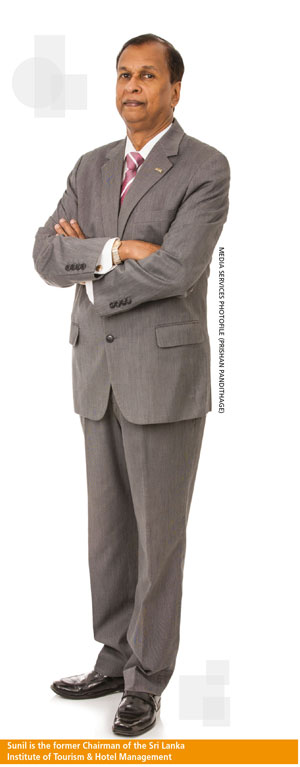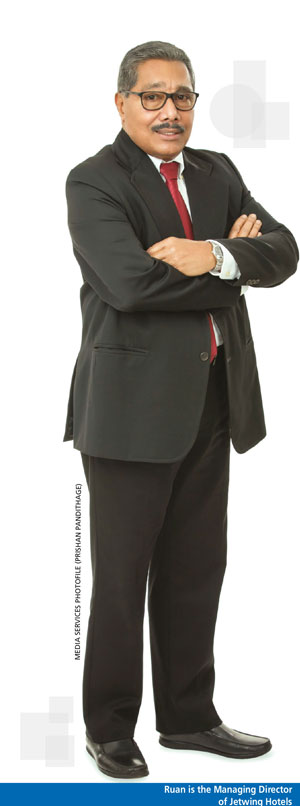TOURISM INDUSTRY
SHORT TAKES
Compiled by Savithri Rodrigo
Ruan Samarasinghe
Sunil Dissanayake
Q: The main takeaways from tourism in the postwar era are…?
Ruan Samarasinghe (RS): The overall health of the country’s economy and infrastructure has heavily influenced tourism. Moreover, the government is targeting tourism earnings to become the largest contributor to the economy as well as for tourist arrivals to double by next year.
Sunil Dissanayake (SD): Since 2009, we have witnessed substantial growth in tourist arrivals especially from China and India whilst maintaining traditional European markets. Hotel capacity has also increased with a specific focus on the luxury segment of premium range boutique hotels.
Q: Has our tourism industry performed up to expectations?
RS The arrivals figure is over two million for 2018, up from approximately 500,000 in 2009. So the industry is performing well and generated US$ 4 billion last year.
SD While the industry has performed well, we need to focus on markets in the Far East. Australia has gained ground with the launch of direct flights from Melbourne. And Edelweiss Air from Zurich offers a boost as regards Europe. There are daily direct flights to London.
Q: What are the priority areas to boost and sustain tourism growth?
RS Introduce regulations to manage visitor numbers to cultural and nature sites, divert tourists to new and less known areas, promote places of interest and improve visitor info or management facilities, and encourage unique experiences that benefit local communities.
SD The digital marketing and ‘So Sri Lanka’ brand identity campaigns will contribute immensely to the growth factor. This will add impetus to the tourism industry in general in tandem with the development of domestic airports and airlines.
Q: And what would be the key economic outcomes of such ventures?
RS Developing Sri Lanka’s rural community must be linked to tourism. Hotels should be built in harmony with the environment and community aspirations.
SD The direct contribution to revenue and foreign exchange growth from tourism will boost direct as well as indirect employment.
Q: What are the main challenges facing the tourism industry at present?
RS High levels of pollution, ineffective law and order, ad hoc hotel construction, unregulated informal sector, high taxes and inconsistent policies.
SD Attracting youth to join the tourism industry, and hospitality and hotel trades, as other industries offer more attractive entry-level salaries.
Q: Is there adequate public-private partnership in promoting the destination?
RS Near end 2018, the long awaited destination marketing campaign was launched in London as a public private partnership. Until then, the private sector usually promoted the destination.
SD Yes, and a fine example would be the collaboration between the public and private sectors in developing the ‘So Sri Lanka’ brand identity.
Q: How can Sri Lanka develop its tourism offering?
RS Sri Lanka needs extensive international branding and positioning, an improvement in connectivity and modern technology.
SD Introducing domestic flights from the main airports for better connectivity with international arrivals at Bandaranaike International Airport (BIA).
Q: Which markets in particular should the industry target?
RS The UK, Germany, France, Italy, India, China, the Middle East, Australia, Scandinavia and the US.
SD A greater focus on the Far East, Australia and the Middle East especially in the summer to promote Sri Lanka’s hill country. 
Q: What is your take on perceptions that tourism growth is leading to the degradation of the natural environment?
RS Conscious decisions in regard to hotel design and operations can mitigate the impact, and contribute to protecting nature. Maximum use of renewable energy and effective waste management strategies can reduce operational impacts while integrating building design with existing vegetation or improving local habitats to create safe havens for threatened biodiversity.
SD In my opinion, this is only a perception in some quarters. I think that all agencies connected with the environment and natural assets are actively involved in ecological preservation – although there may be some isolated incidents that must be dealt with.
Q: Is Sri Lanka any closer to identifying its target tourism market – i.e. finding its niche?
RS Travellers in their middle age and above were previously in the majority. Today, 40 percent of travellers are between 20 and 30.
SD Our niche target for the future will be the young freelance traveller in a market dominated by the demographic known as millennials.
Q: How can the industry attract greater large-scale investments?
RS It requires a consistent foreign direct investment (FDI) policy to attract large-scale funds. A separate agency must be set up to facilitate approvals and overcome roadblocks.
SD This can be done through tax and import incentives, which is similar to the paradigms of the 1970s when structured tourism promotion initiatives took root in Sri Lanka.
Q: What more is required of the industry workforce in terms of skills and talent?
RS Upgrade the Sri Lanka Institute of Tourism & Hotel Management, encourage global hotel schools and regularly raise NVQ standards.
SD There is a need to target and improve language and communication skills – especially in English, Mandarin, Hindi and Arabic.
Q: How can Sri Lanka attract better human resources to the tourism industry?
RS Awareness campaigns with school principals and students in rural schools. Better remuneration and working conditions, and positive perceptions of the sector, would be incentives too.
SD This can be achieved through interaction with potential resources at the school and university levels, and via targeted programmes for parents, schoolteachers and principals.
Q: Are there global travel trends that the industry needs to take cognisance of?
RS Travellers today seek authentic local experiences, using the informal sector for home stays. Millennial travel needs must be recognised.
SD The tourism industry needs to take cognisance of millennials, understand their needs and design its offerings to cater to their aspirations.
Q: Where do you see the tourism industry five years or so down the line?
RS The tourism industry will be the largest foreign exchange earner and Sri Lanka will be one of the most sought after destinations in the world.
SD Sri Lanka will hopefully achieve the targeted five million tourist arrivals and be the main foreign exchange earner for the national economy.
Ruan Samarasinghe is the Managing Director of Jetwing Hotels
Sunil Dissanayake is the former Chairman of the Sri Lanka Institute of Tourism & Hotel Management







Leave a comment